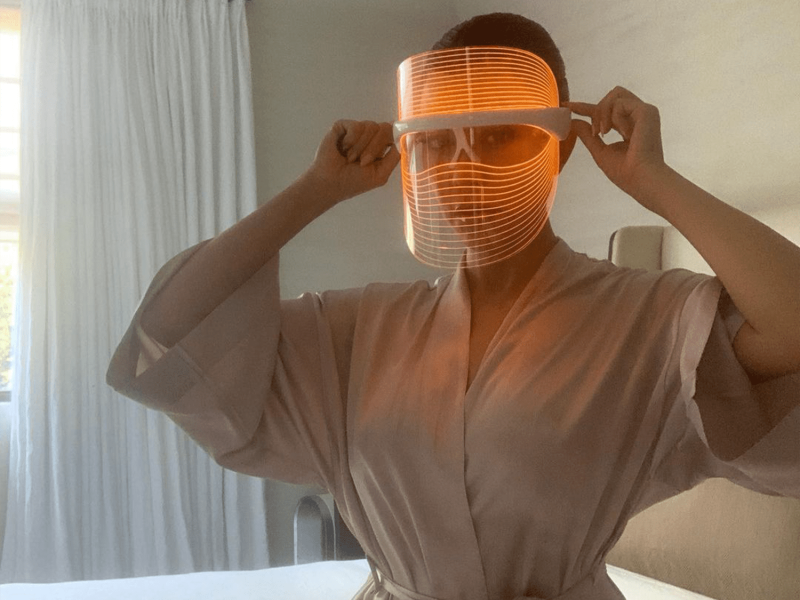
What to Consider How To Use The Final Takeaway
As we age, our skin concerns can become more prominent. Whether you start to notice fine lines and wrinkles, skin thinning, discoloration, or even acne, it is hard to find a one-size-fits-all solution. Lucky for us, there is one at-home device that is equal parts trendy and effective—the LED mask.
Light-emitting diode masks, or LED masks for short, are powerful tools that utilize light therapy to target the common signs of aging. At-home light therapy has come a long way over the years, and having a device on hand can work wonders for your skin.
That being said, with dozens of different LED products on the market, knowing which device is right for your specific skin needs may be tricky. Below, we tapped experts to explain how LED masks work, what skin conditions they can help with, and how to choose the right device for you. Consider this your foolproof LED mask guide just in time to snag one on sale this Black Friday.
What Are LED Masks?
Let’s start with the basics of light therapy. “LED masks use various wavelengths to penetrate the skin at different depths,” New York-based dermatologist Dr. Ryan Turner says. Light therapy is generally defined as a non-invasive treatment used to enact change within the skin cell.
Several light colors provide unique benefits. For example, dermatologic surgeon and brand founder Dr. Dennis Gross explains that blue LED has antibacterial properties that are beneficial for acne-prone skin and can contribute to healthy oil production while purifying the lining of the pores. Red light, on the other hand, is said to stimulate the fibroblast cells responsible for collagen production and reduce redness and inflammation, according to Dr. Turner. For this reason, red light is the most common color used in LED masks.
What Skin Conditions Do LED Masks Treat?
As we mentioned above, depending on the specific color of the light, LED masks can help with several skin conditions. However, since most LED masks contain red light, they are generally considered anti-aging treatment devices. This is mainly because of their ability to boost collagen production. "As collagen levels increase, the skin appears firmer and more youthful, with a reduction in fine lines and wrinkles," esthetician Edyta Jarosz explains.
Dullness is another key concern that an LED mask can address. “LED light therapy can boost circulation, which enhances radiance and gives the complexion a youthful glow,” Jarosz says. By improving blood flow to the skin and stimulating cell turnover, these treatments help create a smoother, more vibrant surface.”
Beyond aging issues, LED masks can also be used to repair forms of sun damage. As board-certified dermatologist Dr. Robyn Gymrek explains, “Red light increases cellular energy production, which supports skin tissue repair to areas that may have been damaged by photoaging.”
Potential Side Effects
LED masks are designed to be used in the comfort of your home and, therefore, have few safety concerns. "They do not emit harmful UV rays and are noninvasive, making them generally safe to use," board-certified dermatologist Dr. Nathan Newman says. He tells us that side effects are minimal but may include mild skin dryness, redness, or eye strain if used without eye protection.
Consulting with your dermatologist before using a new device is always a good idea. Dr. Turner explains that certain medications or skin conditions can increase your sensitivity to light, which may affect your results. Further, Dr. Gymrek notes that LED masks that heat can potentially worsen melasma pigmentation.
What to Consider
It goes without saying that there are many LED masks to choose from. When scrolling through all of your options, there are a few key factors to consider. Go through each point below to ensure that whichever mask you purchase is effective, safe, and meets the minimum quality standards.
Wavelengths
In light therapy, the colors and wavelengths work together to produce results. "The wavelength determines how effective the treatment will be," explains Jarosz. Put simply, for each different color, there are clinically proven wavelengths that provide optimal results. "Red light spans the wavelengths 610 nm–650 nm. However, clinical research has found that wavelengths around 630 to 633 specifically reduce oil or sebum production, inflammation, pigmentation, and redness while stimulating cellular repair," Dr. Gymrek explains.
In terms of masks, Dr. Turner tells us that the best options have lights that offer a variety of wavelengths, even if the mask targets one concern. "A quality red light LED mask should have a mix of red, near-infrared, and infrared, and possibly yellow and amber lights to treat your skin with more than just one wavelength and provide a more robust treatment," he explains.
Number of Lights
According to Jarosz, the number of LED bulbs in a mask directly affects how evenly and effectively it distributes light across your face. "More lights generally mean better, more consistent coverage and quicker results. They also tend to deliver stronger, more consistent therapy," she says. When shopping for an LED mask, Dr. Turner notes it's best to look for a mask with at least 50 to 100 lights.
Clinical Research and Safety
Multiple experts note that while most devices are FDA-approved, finding an LED mask whose benefits are backed by clinical studies and not just consumer studies will ensure that it is safe and effective for at-home use. Knowing that studies support the mask’s effectiveness can provide peace of mind, particularly when purchasing premium models.
Average Cost
Dr. Newman tells us that LED masks range from around $100 for basic home-use models to over $1,000 for high-end devices with clinical-grade technology. "The price often reflects the quality, number of lights, and variety of wavelengths offered," he says.
How to Use LED Masks
All the experts stress the importance of using an LED mask on clean, dry skin. “This will ensure maximum light penetration,” Dr. Newman says. Avoiding products like retinoids or exfoliating acids before LED treatments is always best, as they can make your skin more sensitive. If you are using these kinds of products regularly, Jarosz suggests applying them on days when you’re not doing LED therapy.
Once ready, place the mask on the target area and follow the manufacturer's instructions. Each device's usage times may differ, but as Jarosz explains, starting with shorter sessions (about 10 minutes) two to three times a week will help your skin gradually adjust. Eye protection is also heavily recommended. "Even if your mask includes built-in eye protection, closing your eyes or wearing additional protection can help reduce any potential eye strain from the bright lights," Jarosz says.
Consistency is key to seeing visible improvements. Plus, using the mask regularly over several weeks will provide long-term benefits. With that in mind, Dr. Gross says you can expect to see results for acne in about 3-5 treatments and about 3-4 weeks for fine lines and wrinkles.
The Final Takeaway
LED masks are a popular at-home treatment that can effectively diminish wrinkles, increase collagen production and elasticity, and improve skin's appearance over time. While they are safe to use at home, it is important to follow the instructions and consult your dermatologist beforehand. Since an LED mask is an investment, you want to always follow proper protocols to maximize its benefits.

